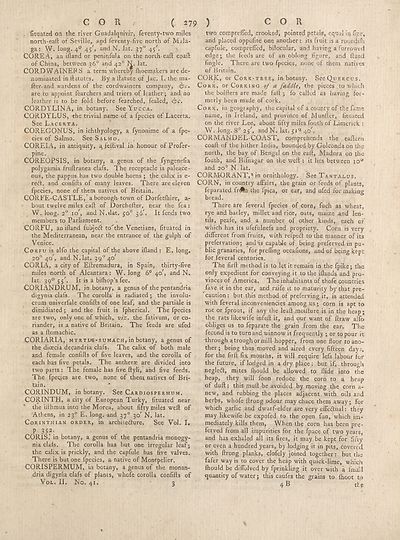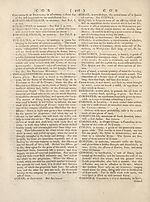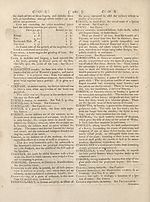Encyclopaedia Britannica; or, A dictionary of arts and sciences, compiled upon a new plan … > Volume 2, C-L
(307) Page 279
Download files
Complete book:
Individual page:
Thumbnail gallery: Grid view | List view

COR ( 279 ) COR
. fituated on the river Guadalquivir, feventy-two miles
north-eatt of Seville, agd feventy-five north of Mala¬
ga: W. long. 40 45', andN. lat. 370 45'.
COREA, an ifland or peninfula on the north-call cpaft
of China, between 36° and 420 N. lat.
CORDWAINEP S a term wliereby Ihoemakers are de¬
nominated in ftatutes. By a llatute of Jac. I. the ma-
Iter. and wardens of the cordwainers company,
are to appoint fearchers and triers of leather; and no
leather is to be fold before fearched, feaied., &c.
CORDYLINA, in botany. See Yucca.
CORDYLUS, -the trivial name of a fpecies of Lacerta.
See Lacerta.
COREGONUS, in ichthyology, a fynonime of a fpe¬
cies of Salmo. See Sal mo.
COREIA, in antiquity, a^feftival in honour of Profer-
pine.
COREOPSIS, in botany, a genus of the fyngenefia
polygamia frullranea clafs. The receptacle is paleace¬
ous, the pappus has two double horns ; the calix is e-
re<5t, and confifts of many leaves. There are eleven
fpecies, none of them natives of Britain.
CORFE-CASTLE, ‘ a borough- town of Dorfetlhire, a-
bout twelve miles eaft of Dorchefter, near the fea:
W. long. 20 io/, and N.dat. 50° $()'. It fends two
members to Parliament.
CORFU, an illand fubjedt to"the Venetians, fituated in
the Mediterranean, near the entrance of the gulph of
Venice.
Corfu is alfo the capital of the above ifland : E. long.
20° 40', and N.lat. 390 40'
CORIA, a city of Eltremadura, in Spain, thirty-five
miles north of Alcantara: W. long 6° 40/, and N.
lat. 390 jj'. It is a bilhop’s fee.
CORIANDRUM, in botany, a genus of the pentandria
digynia clafs. The corolla is radiated; the involu-
crum univerfale confifts of one leaf, and the partiale is
dimidiated; and the fruit is fpherical. The fpecies
are two, only one of which, viz. the fativum, or co¬
riander, is a native of Britain. The feeds are ufed
as a ftomachic.
CORIARIA, MYRTL»E-suMACH,inbotany, a genus of
the dicecia decandria clafsr The calix of both male
and female confirts of five leaves, and the corolla of
each has five petals. The antherae are divided into
two parts : The female has five ftyli, and five feeds.
The fpeQes are two, none of them natives of Bri¬
tain.
CORINDUM, in botany. See Cardiospermum.
CORINTH, a city of European Turky, fituated near
* the ifthmus into the Morea, about fifty miles weft of
Athens, in 230 E. long.-and 370 30' N. lat.
Corinthian order, in archue&ure. See Vol. I.
P 352-
CORIS, in botany, a genus of the pentandria monogy-
nia clals. The corolla has but one irregular leaf;
the calix is prickly, and the capfule has five valves.
There is but one fpecies, a-native of Montpelier.
CORISPERMUM, in botany, a genus of the monan-
dria digynia clafs of plants, whofe corolla confifts of
Vol. II. No. 41. 3
two comprefled, crooked, pointed petals, equal in fize,
and placed oppofite one another: its fruit is a rpundilh
capfule, comprefled, bilocular, an^ having a furrowed
edge; the feeds are of an oblong figure, and ftand
Angle. There are two fpecies, none of them natives
of Britain.
CORK, or Cork-tree, in botany. SeeQuERCus.
Cork, or Corking of a faddle, the pieces to which
the bolfters are made faft ; fo called as having for¬
merly been made of cork.
Cork, in geography, the capital of a county of the fame
name, in Ireland, and province of Munfter, fituated
on the river Lee, about fifty miles fouth of Limerick :
W. long. 8° 2y/, andN. lat. 51“* 40'.
CORMANDEL-COAST, comprehends the eaftern
coaft of the hither India, bounded by Golconda on the
north, the bay of Bengal on the eaft, Madura on the
fouth, and Bifnagar on the weft : it lies between io°
and 200 N. lat.
CORMORANT,* in ornithology. See Tantalus.
CORN, in country affairs, the grain or feeds of plants,
feparated fn#n the fpica, or ear, and ufed for making
bread.
There are feveral fpecies of corn, fuch as wheat,
rye and barley, millet and rice, oats, maize and len¬
tils, peafe, and a number of other kinds, each of
which has its ufefulnefs and propriety. Corn is very
different from fruits, with refpeft to the manner of its
prefervation; and is capable of being preferved in pu¬
blic granaries, for prefling occafions, and of being kept
for feveral centuries.
The firft method is to let it remain in the fpike; the
only expedient for conveying it to the iflands and pro¬
vinces of America. The inhabitants of thofe countries
fave it in the ear, and raife it to maturity by that pre¬
caution: but this method of preferving it, is attended
with feveral inconveniencies among us ; corn is apt to
rot or fprout, if any the leaft moifture is in the heap;
the rats likewife infeft it, and our want of ftraw alfo
obliges us to feparate the grain from the ear. The
fecond is to turn and winnow it frequently ; or to pour it
through a trough or mill-hopper, from one floor to ano¬
ther ; being thus moved and aired every fifteen day;,
for the firft fix months, it will require lefs labour for
the future, if lodged in a dry place : but if, through
negletft, mites ftiould be allowed to Aide into the
heap, they will foon reduce the corn to a heap
of dull: this muft be avoided by moving the corn a-
new, and rubbing the places adjacent with oils and
herbs, whofe ftrong odour may chace them away; for
which garlic and dwarf-elder are very effectual: they
may likewife be expofed to the open fun, which im¬
mediately kills them, When the corn has been pre¬
ferved from all impurities for the fpace of two years,
and has exhaled all its fires, it may be kept for fifty
or even a hundred years, by lodging it in pits, covered
with ftrong planks, clofely joined together: but the
fafer way is to cover the heap with quick-lime, which
ftiould be diffolved by fprinkling it over with a imall
quantity of water; this caufes the grains to (hoot to
4 B thp
. fituated on the river Guadalquivir, feventy-two miles
north-eatt of Seville, agd feventy-five north of Mala¬
ga: W. long. 40 45', andN. lat. 370 45'.
COREA, an ifland or peninfula on the north-call cpaft
of China, between 36° and 420 N. lat.
CORDWAINEP S a term wliereby Ihoemakers are de¬
nominated in ftatutes. By a llatute of Jac. I. the ma-
Iter. and wardens of the cordwainers company,
are to appoint fearchers and triers of leather; and no
leather is to be fold before fearched, feaied., &c.
CORDYLINA, in botany. See Yucca.
CORDYLUS, -the trivial name of a fpecies of Lacerta.
See Lacerta.
COREGONUS, in ichthyology, a fynonime of a fpe¬
cies of Salmo. See Sal mo.
COREIA, in antiquity, a^feftival in honour of Profer-
pine.
COREOPSIS, in botany, a genus of the fyngenefia
polygamia frullranea clafs. The receptacle is paleace¬
ous, the pappus has two double horns ; the calix is e-
re<5t, and confifts of many leaves. There are eleven
fpecies, none of them natives of Britain.
CORFE-CASTLE, ‘ a borough- town of Dorfetlhire, a-
bout twelve miles eaft of Dorchefter, near the fea:
W. long. 20 io/, and N.dat. 50° $()'. It fends two
members to Parliament.
CORFU, an illand fubjedt to"the Venetians, fituated in
the Mediterranean, near the entrance of the gulph of
Venice.
Corfu is alfo the capital of the above ifland : E. long.
20° 40', and N.lat. 390 40'
CORIA, a city of Eltremadura, in Spain, thirty-five
miles north of Alcantara: W. long 6° 40/, and N.
lat. 390 jj'. It is a bilhop’s fee.
CORIANDRUM, in botany, a genus of the pentandria
digynia clafs. The corolla is radiated; the involu-
crum univerfale confifts of one leaf, and the partiale is
dimidiated; and the fruit is fpherical. The fpecies
are two, only one of which, viz. the fativum, or co¬
riander, is a native of Britain. The feeds are ufed
as a ftomachic.
CORIARIA, MYRTL»E-suMACH,inbotany, a genus of
the dicecia decandria clafsr The calix of both male
and female confirts of five leaves, and the corolla of
each has five petals. The antherae are divided into
two parts : The female has five ftyli, and five feeds.
The fpeQes are two, none of them natives of Bri¬
tain.
CORINDUM, in botany. See Cardiospermum.
CORINTH, a city of European Turky, fituated near
* the ifthmus into the Morea, about fifty miles weft of
Athens, in 230 E. long.-and 370 30' N. lat.
Corinthian order, in archue&ure. See Vol. I.
P 352-
CORIS, in botany, a genus of the pentandria monogy-
nia clals. The corolla has but one irregular leaf;
the calix is prickly, and the capfule has five valves.
There is but one fpecies, a-native of Montpelier.
CORISPERMUM, in botany, a genus of the monan-
dria digynia clafs of plants, whofe corolla confifts of
Vol. II. No. 41. 3
two comprefled, crooked, pointed petals, equal in fize,
and placed oppofite one another: its fruit is a rpundilh
capfule, comprefled, bilocular, an^ having a furrowed
edge; the feeds are of an oblong figure, and ftand
Angle. There are two fpecies, none of them natives
of Britain.
CORK, or Cork-tree, in botany. SeeQuERCus.
Cork, or Corking of a faddle, the pieces to which
the bolfters are made faft ; fo called as having for¬
merly been made of cork.
Cork, in geography, the capital of a county of the fame
name, in Ireland, and province of Munfter, fituated
on the river Lee, about fifty miles fouth of Limerick :
W. long. 8° 2y/, andN. lat. 51“* 40'.
CORMANDEL-COAST, comprehends the eaftern
coaft of the hither India, bounded by Golconda on the
north, the bay of Bengal on the eaft, Madura on the
fouth, and Bifnagar on the weft : it lies between io°
and 200 N. lat.
CORMORANT,* in ornithology. See Tantalus.
CORN, in country affairs, the grain or feeds of plants,
feparated fn#n the fpica, or ear, and ufed for making
bread.
There are feveral fpecies of corn, fuch as wheat,
rye and barley, millet and rice, oats, maize and len¬
tils, peafe, and a number of other kinds, each of
which has its ufefulnefs and propriety. Corn is very
different from fruits, with refpeft to the manner of its
prefervation; and is capable of being preferved in pu¬
blic granaries, for prefling occafions, and of being kept
for feveral centuries.
The firft method is to let it remain in the fpike; the
only expedient for conveying it to the iflands and pro¬
vinces of America. The inhabitants of thofe countries
fave it in the ear, and raife it to maturity by that pre¬
caution: but this method of preferving it, is attended
with feveral inconveniencies among us ; corn is apt to
rot or fprout, if any the leaft moifture is in the heap;
the rats likewife infeft it, and our want of ftraw alfo
obliges us to feparate the grain from the ear. The
fecond is to turn and winnow it frequently ; or to pour it
through a trough or mill-hopper, from one floor to ano¬
ther ; being thus moved and aired every fifteen day;,
for the firft fix months, it will require lefs labour for
the future, if lodged in a dry place : but if, through
negletft, mites ftiould be allowed to Aide into the
heap, they will foon reduce the corn to a heap
of dull: this muft be avoided by moving the corn a-
new, and rubbing the places adjacent with oils and
herbs, whofe ftrong odour may chace them away; for
which garlic and dwarf-elder are very effectual: they
may likewife be expofed to the open fun, which im¬
mediately kills them, When the corn has been pre¬
ferved from all impurities for the fpace of two years,
and has exhaled all its fires, it may be kept for fifty
or even a hundred years, by lodging it in pits, covered
with ftrong planks, clofely joined together: but the
fafer way is to cover the heap with quick-lime, which
ftiould be diffolved by fprinkling it over with a imall
quantity of water; this caufes the grains to (hoot to
4 B thp
Set display mode to:
![]() Universal Viewer |
Universal Viewer | ![]() Mirador |
Large image | Transcription
Mirador |
Large image | Transcription
Images and transcriptions on this page, including medium image downloads, may be used under the Creative Commons Attribution 4.0 International Licence unless otherwise stated. ![]()
| Encyclopaedia Britannica > Encyclopaedia Britannica; or, A dictionary of arts and sciences, compiled upon a new plan … > Volume 2, C-L > (307) Page 279 |
|---|
| Permanent URL | https://digital.nls.uk/144917308 |
|---|
| Attribution and copyright: |
|
|---|
| Description | Ten editions of 'Encyclopaedia Britannica', issued from 1768-1903, in 231 volumes. Originally issued in 100 weekly parts (3 volumes) between 1768 and 1771 by publishers: Colin Macfarquhar and Andrew Bell (Edinburgh); editor: William Smellie: engraver: Andrew Bell. Expanded editions in the 19th century featured more volumes and contributions from leading experts in their fields. Managed and published in Edinburgh up to the 9th edition (25 volumes, from 1875-1889); the 10th edition (1902-1903) re-issued the 9th edition, with 11 supplementary volumes. |
|---|---|
| Additional NLS resources: |
|

